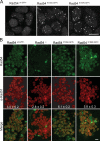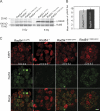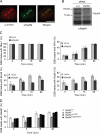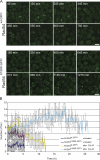ATP-dependent and independent functions of Rad54 in genome maintenance
- PMID: 21357745
- PMCID: PMC3051825
- DOI: 10.1083/jcb.201011025
ATP-dependent and independent functions of Rad54 in genome maintenance
Abstract
Rad54, a member of the SWI/SNF protein family of DNA-dependent ATPases, repairs DNA double-strand breaks (DSBs) through homologous recombination. Here we demonstrate that Rad54 is required for the timely accumulation of the homologous recombination proteins Rad51 and Brca2 at DSBs. Because replication protein A and Nbs1 accumulation is not affected by Rad54 depletion, Rad54 is downstream of DSB resection. Rad54-mediated Rad51 accumulation does not require Rad54's ATPase activity. Thus, our experiments demonstrate that SWI/SNF proteins may have functions independent of their ATPase activity. However, quantitative real-time analysis of Rad54 focus formation indicates that Rad54's ATPase activity is required for the disassociation of Rad54 from DNA and Rad54 turnover at DSBs. Although the non-DNA-bound fraction of Rad54 reversibly interacts with a focus, independent of its ATPase status, the DNA-bound fraction is immobilized in the absence of ATP hydrolysis by Rad54. Finally, we show that ATP hydrolysis by Rad54 is required for the redistribution of DSB repair sites within the nucleus.
Figures








Similar articles
-
RAD54 is essential for RAD51-mediated repair of meiotic DSB in Arabidopsis.PLoS Genet. 2021 May 18;17(5):e1008919. doi: 10.1371/journal.pgen.1008919. eCollection 2021 May. PLoS Genet. 2021. PMID: 34003859 Free PMC article.
-
Mouse Rad54 affects DNA conformation and DNA-damage-induced Rad51 foci formation.Curr Biol. 1999 Mar 25;9(6):325-8. doi: 10.1016/s0960-9822(99)80142-0. Curr Biol. 1999. PMID: 10209103
-
Differential contributions of mammalian Rad54 paralogs to recombination, DNA damage repair, and meiosis.Mol Cell Biol. 2006 Feb;26(3):976-89. doi: 10.1128/MCB.26.3.976-989.2006. Mol Cell Biol. 2006. PMID: 16428451 Free PMC article.
-
Discrete roles for Rad54 and Rdh54 during homologous recombination.Curr Opin Genet Dev. 2021 Dec;71:48-54. doi: 10.1016/j.gde.2021.06.013. Epub 2021 Jul 20. Curr Opin Genet Dev. 2021. PMID: 34293661 Review.
-
Rad54, the motor of homologous recombination.DNA Repair (Amst). 2010 Mar 2;9(3):286-302. doi: 10.1016/j.dnarep.2009.12.006. Epub 2010 Jan 20. DNA Repair (Amst). 2010. PMID: 20089461 Free PMC article. Review.
Cited by
-
Mathematical model of chromosomal dynamics during DNA double strand break repair in budding yeast.Biophys Physicobiol. 2022 Apr 5;19:1-12. doi: 10.2142/biophysico.bppb-v19.0012. eCollection 2022. Biophys Physicobiol. 2022. PMID: 35749629 Free PMC article.
-
Chromosome territories reposition during DNA damage-repair response.Genome Biol. 2013 Dec 13;14(12):R135. doi: 10.1186/gb-2013-14-12-r135. Genome Biol. 2013. PMID: 24330859 Free PMC article.
-
A conserved sequence extending motif III of the motor domain in the Snf2-family DNA translocase Rad54 is critical for ATPase activity.PLoS One. 2013 Dec 16;8(12):e82184. doi: 10.1371/journal.pone.0082184. eCollection 2013. PLoS One. 2013. PMID: 24358152 Free PMC article.
-
Role of Mitochondria-Associated Endoplasmic Reticulum Membrane in Inflammation-Mediated Metabolic Diseases.Mediators Inflamm. 2016;2016:1851420. doi: 10.1155/2016/1851420. Epub 2016 Dec 15. Mediators Inflamm. 2016. PMID: 28074080 Free PMC article. Review.
-
Rad54L promotes bladder cancer progression by regulating cell cycle and cell senescence.Med Oncol. 2022 Sep 7;39(12):185. doi: 10.1007/s12032-022-01751-7. Med Oncol. 2022. PMID: 36071250
References
Publication types
MeSH terms
Substances
LinkOut - more resources
Full Text Sources
Molecular Biology Databases
Research Materials
Miscellaneous

